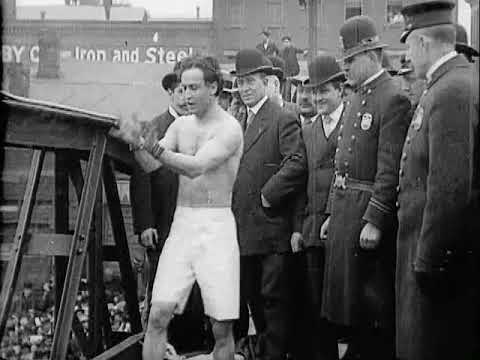Behind the Scenes: The Preparation and Risks Involved in Houdini’s Escape Acts
Harry Houdini’s death-defying escapes captivated audiences worldwide. Few knew the intense preparation and risks behind each performance. His successful escapes relied on a blend of physical skills, technical knowledge of locks, and carefully planned deception techniques that took years to master.
Breaking free from handcuffs and chains was just the beginning. Each act demanded countless hours of practice, remarkable flexibility, and the ability to stay calm under extreme pressure.
You might be surprised to learn that Houdini often performed while dealing with injuries and sprains from previous shows.
Before attempting his famous underwater escapes, Houdini would study every detail of the chains, boxes, and locks used in the performance. He trained extensively to hold his breath and developed techniques to manipulate restraints while submerged. His dedication to perfecting these skills meant the difference between a successful escape and disaster.
Houdini’s Physical Conditioning Regimen

Physical fitness formed the backbone of Houdini’s remarkable escape abilities. His rigorous training program combined strength, flexibility, and endurance work with careful attention to diet.
Daily Exercise and Strength Training
You’ll find Houdini’s daily workout routine was remarkably ahead of its time. He began each morning with 100 pushups and 100 situps to maintain core strength.
His weight training focused on grip strength – essential for manipulating locks and chains. He used dumbbells, but also practiced unusual exercises like finger pulls and wrist rotations.
Swimming played a crucial role in his fitness plan. He swam for 30 minutes daily, often practicing underwater breath control while swimming laps.
Flexibility and Endurance Practices
Flexibility training helped Houdini master the art of escape from handcuffs and tight spaces. He practiced dislocating his shoulders and hips safely through controlled stretching.
Yoga-like poses became part of his daily routine. He spent hours perfecting backbends and contortions.
His endurance work included running 5 miles daily and climbing stairs while holding his breath. These exercises built the stamina needed for complex underwater escapes.
Diet and Nutrition for Peak Performance
Your body needs proper fuel for intense physical training. Houdini understood this principle and maintained a strict diet.
He ate six small meals daily, focusing on lean proteins and vegetables. Chicken, fish, and eggs formed the core of his protein intake.
He avoided alcohol completely and limited sugar intake. Instead, he drank large quantities of water and herbal tea to stay hydrated during his demanding performances.
Technical Rehearsals and Training

Harry Houdini’s escape acts required intense preparation, technical expertise, and countless hours of practice. His dedication to mastering both the physical and mechanical aspects of each escape made his acts seem impossible to audiences.
Simulating High-Risk Scenarios
You need specialized equipment to practice dangerous escapes safely. Houdini used a private training room with padded floors and multiple safety measures.
He would time each practice run with a stopwatch, pushing himself to reduce escape times by seconds. This became crucial for underwater escapes and other life-threatening stunts.
Your body must adapt to extreme conditions. Practice sessions often involve holding your breath underwater, dealing with tight spaces, and managing physical discomfort.
Mastering Lock Picking and Restraint Techniques
Physical agility and flexibility form the foundation of escape artistry. You must study various lock mechanisms and practice with different types of restraints daily.
Key skills include:
- Lock manipulation
- Rope escape techniques
- Handcuff picking
- Chain and shackle removal
Regular maintenance of your tools and equipment becomes essential. You inspect each lock and restraint before practice sessions.
Collaboration with Assistants and Engineers
Your team plays a vital role in both preparation and performance. Assistants must know exact timing and emergency procedures.
Engineers help design and test safety mechanisms. They create backup release systems and modify equipment for specific venues.
Communication protocols are established during rehearsals. Every team member learns visual signals and verbal cues for emergencies.
Practice sessions include simulated failures to prepare for worst-case scenarios. Your crew must react quickly if something goes wrong.
Safety Protocols and Precautions

Surviving dangerous escapes required careful preparation and multiple layers of protection. Water escapes posed significant risks including oxygen deprivation and hypothermia.
Redundant Safety Measures
Your first line of defense must include multiple hidden tools and picking mechanisms concealed throughout your clothing and body. Keep at least three separate lock picks in different locations.
A trusted assistant should monitor every performance from a hidden vantage point, ready to intervene at a moment’s notice. This person must know the exact sequence of the escape.
You need to practice holding your breath for extended periods. Regular training in a controlled environment helps build lung capacity and keeps you calm under pressure.
Emergency Plans and Backup Strategies
Your support team must position emergency axes and crowbars at strategic points around the performance area. Mark these locations clearly but discreetly.
Install quick-release mechanisms in all restraints, even when performing the famous Chinese Water Torture routine. Test these releases multiple times before each show.
Keep bolt cutters and glass-breaking tools within reach of at least two assistants. They must be able to free you within 30 seconds.
The Role of Medical Personnel
A physician must examine you before attempting any underwater or suspended escapes. Pay special attention to blood pressure and heart rate measurements.
Position medical staff with resuscitation equipment in the wings during every performance. They need clear sight lines to the performance area.
Brief the medical team on the specific risks of each escape. Give them detailed timing expectations and signal systems to recognize genuine distress.
Analysis of Specific High-Risk Performances
Houdini’s most dangerous performances pushed the limits of human endurance and required meticulous preparation. These acts put him face-to-face with drowning, suffocation, and physical injury while thrilling audiences worldwide.
The Water Torture Cell
The underwater escape stunts posed significant risks including hypothermia and oxygen deprivation. Houdini would be suspended upside-down in a glass tank filled with cold water.
You might wonder how he prepared for such feats. He trained extensively in holding his breath and practiced the precise movements needed to escape while inverted.
The cell measured 6 feet tall by 3 feet wide. Restraints included ankle stocks and heavy chains. The water temperature rarely exceeded 50 degrees Fahrenheit.
The Buried Alive Stunt
This act challenged Houdini to escape from a wooden coffin buried under 6 feet of earth. His escape required careful engineering of the coffin structure and breathing system.
The weight of the soil posed a real threat of crushing the coffin. A collapse could mean instant death.
During one performance, the coffin actually began to crack. Houdini barely managed to signal his assistants for emergency extraction.
The Straitjacket Escape
Escapologists like Houdini made straitjacket escapes look easy, but they demanded incredible strength and flexibility. He often performed this suspended high above city streets.
The key to success lay in creating slack in the jacket’s restraints. Houdini would take a deep breath while being strapped in, then exhale to gain crucial wiggle room.
The process involved dislocating his shoulder to slip free of the sleeves. This repeatedly caused him physical pain and injury.
His fastest recorded escape took only 2 minutes and 37 seconds, setting a world record at the time.
Calculated Dangers and Hidden Mechanisms
Harry Houdini’s escapes relied on precise planning and hidden tools, with every risk carefully measured against the illusion’s impact.
Understanding the Risks Involved
Houdini’s dangerous stunts required extensive preparation and physical conditioning. You might think his acts were pure chance, but each performance had backup safety measures.
His famous water torture cell required him to hold his breath for over three minutes. A hidden release mechanism stayed within reach if anything went wrong.
His team kept medical personnel nearby during particularly risky performances. They monitored time limits carefully, especially during underwater escapes.
Secret Devices and Escape Tools
The lockpicking techniques Houdini mastered relied on small tools hidden in various places. You’d be amazed to learn he could conceal lock picks in his hair, between his teeth, or under his tongue.
For his handcuff escapes, he used specially designed keys and sometimes had duplicate copies sewn into his clothing.
His straitjacket escapes used strategic stretching of the material before performances, making them easier to slip out of while hanging upside down.
The Balance Between Illusion and Reality
You need to understand that Houdini mixed genuine skill with clever deception. His escape from a milk can combined real swimming ability with hidden trap doors.
He maintained physical strength through daily exercise routines. This allowed him to perform genuine feats of flexibility and endurance.
His most impressive tricks often used multiple methods – if one failed, another would work. This redundancy kept him alive through thousands of performances.
Psychological Fortitude and Mental Preparation
Mental strength played a crucial role in Houdini’s ability to perform death-defying escapes. His mastery of psychological techniques and unwavering focus set him apart from other performers of his time.
Overcoming Fear and Anxiety
Remaining calm and steady was essential during confined space escapes, especially when air supply was limited. You must learn to control your breathing and heart rate to manage panic responses.
Houdini developed specific breathing exercises to maintain composure under pressure. These techniques helped him stay focused even when submerged underwater or locked in tight spaces.
Fear management strategies included:
- Breaking down complex escapes into smaller steps
- Practicing in controlled environments first
- Using positive self-talk during performances
- Maintaining a steady routine before each show
Mental Focus and Visualization Techniques
Mental fortitude requires intense concentration and clear visualization. You need to picture each step of your escape before attempting it.
Houdini would spend hours mentally rehearsing his performances. He created detailed mental maps of every lock mechanism and escape sequence.
Key visualization practices:
- Mentally walking through each escape step-by-step
- Imagining successful completion
- Preparing for potential complications
- Maintaining focus despite distractions
Building Confidence Through Repetition
Technical knowledge and physical skill create unshakeable confidence. You must practice each escape hundreds of times until it becomes second nature.
Houdini’s preparation involved testing every possible scenario that could go wrong. He would deliberately create challenging conditions during practice sessions.
Practice elements included:
-
Daily physical conditioning
-
Lock manipulation drills
-
Underwater endurance training
-
Flexibility exercises
Each successful practice reinforced his self-assurance and enhanced his performance abilities.
How Thorough Preparation Contributed to Success
Extensive practice and technical knowledge formed the foundation of Houdini’s seemingly impossible feats. His success came from detailed planning, physical conditioning, and mastery of specialized techniques.
Case Studies of Successful Escapes
Houdini’s handcuff escapes relied on multiple skills working together: technical expertise, physical ability, and clever misdirection. He studied lock mechanisms extensively and maintained a collection of over 1,000 restraints to practice with.
His famous Chinese Water Torture Cell required precise timing and exceptional muscle control. You can see this dedication in how he trained – holding his breath for up to 4 minutes and practicing the escape sequence hundreds of times before performing it.
Lessons Learned from Near Misses
The Mirror Handcuff Challenge of 1904 pushed Houdini to his limits. It took him over an hour to escape, teaching him to better prepare for custom restraints.
Near-drowning incidents led him to implement safety measures:
-
Hidden release mechanisms
-
Trained assistants standing by
-
Emergency access points in water tanks
The Legacy of Houdini’s Methodology
Modern escape artists still follow Houdini’s core preparation principles:
- Thorough equipment inspection
- Regular physical conditioning
- Methodical practice routines
His approach to challenging death through careful preparation changed how performers approach dangerous acts. His influence is seen in contemporary magic’s emphasis on safety protocols and extensive rehearsal.
His training methods revolutionized the art of escape. The combination of physical fitness, technical knowledge, and psychological preparation became the standard for dangerous performances.
Contents





